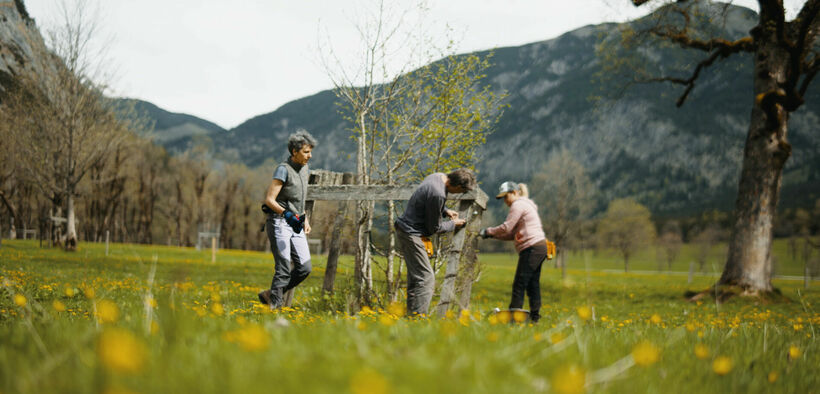Nature Park Karwendel
The Nature Park Karwendel encompasses almost the entire Karwendel massif, covering an area of 739 km² (930 km² including the Bavarian part). It is the largest nature reserve in Tirol and the largest nature park in Austria. The park has a high proportion of natural habitats, including ancient forests and wild rivers. It is home to an impressive variety of species, some of which are rare or endangered in Europe, such as the white-backed woodpecker and the lady's slipper orchid. Hikers can spend hours wandering through unspoilt countryside, spotting marmots, deer and hares, while birds of prey such as buzzards soar overhead.
Exploring the Karwendel
A large nature park like the Karwendel has countless access points. The Nature Park Karwendel begins in Pertisau, on the western shore of Lake Achensee, and is usually accessed via the Falzturn or Gerntal toll roads. However, there are plenty of opportunities for hikers and mountaineers looking to explore deeper into the park, such as walking to the Lamsenjochhütte or crossing over the Plumsjoch into the Risstal.
- Area: 739 km² (incl. the Bavarian part: 930 km²)
- 340 springs
- 1,305 plant species
- 3,035 known animal species
- Largest population of golden eagles in the Alps
- Agriculture: 101 alpine pastures with ca. 10,000 hectares of foraging area
- Elevation profile: 600 to 2,749 metres (Birkkarspitze)
TOLL ROAD
The toll road into the Karwendel valleys (Falzthurn and Gerntal) is open from the end of April to the end of October. It is closed to cars in the remaining months. Prices & detailed information can be found on the official website of the Nature Park Karwendel.
The Nature Park Karwendel was named Nature Park of the Year 2020 by an independent jury of experts, which included representatives from the Federal Environment Agency, Alpine Pearls, the University of Vienna, the Centre for Environmental Education, and ORF Carinthia. It scored 129 out of a maximum of 150 points in the evaluation across areas such as nature conservation, recreation and tourism, environmental education, regional development, and public relations. The award also recognized the well-organized junior ranger programme and the commitment of volunteers working in the Nature Park Karwendel.
The Karwendel mountains have a long history of human activity. In addition to alpine pasture farming, which has been documented since the 12th century, hunting has also played a significant role. The first recorded mention of hunting dates back to 1420. Perhaps the most famous hunter associated with the Karwendel is Emperor Maximilian (1459-1519), who appreciated the abundance of chamois. Hunting still plays an important role today, and there are still noble tenants.
Established as a nature reserve in 1928, the Nature Park Karwendel is one of the oldest protected areas in Central Europe. Initially, the nature conservation movement focused on protecting individual plants and animals. Today, the emphasis has shifted to the conservation of overall biodiversity and natural processes. This broader approach is reflected in the collaborative efforts of stakeholders that shape the contemporary challenges of today’s protected area management. These range from traditional projects such as the reforestation of the Ahornboden to environmental education and a wide array of nature excursions offered to both visitors and locals.
The large scree slopes wind down from the mountains like giant grey snakes. In good weather, they lie motionless, but during heavy summer rains, they are set in motion, bringing new material "from above". Another geological peculiarity is Tiroler Steinöl®, which has been extracted from oil shale in the Bächental since the 1950s and processed into high-quality cosmetic products.
About 200 million years ago, a significant change occurred in the natural environment. Flora and fauna underwent considerable transformations, leading to a global mass extinction. This event marked the end of the Triassic period and the beginning of the Jurassic period. Evidence of this transition can still be seen in many rock formations, notably on the Kuhjoch in the Nature Park Karwendel. In the summer of 2011, an oversized golden nail was installed at this site. In geological terms, this "golden nail" marks a specific geological formation and serves as a global reference point. There are 60 such "golden spikes" around the world, and the one in the Nature Park Karwendel is the first in Austria. Due to the difficulty of accessing this unique natural phenomenon, a new themed trail called "Golden Nail" has been created near the visitor centre in Hinterriss. This trail educates visitors about the global geological significance of the Karwendel region.





